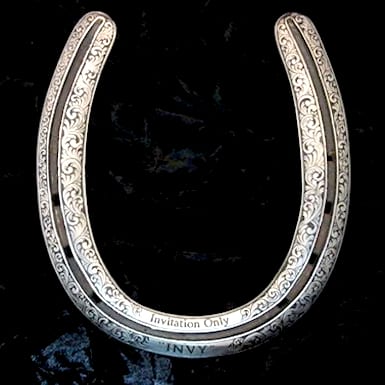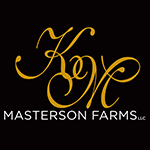There’s a special meaning to a great horse’s shoes. A horse’s hooves are what carry it and its rider through a pattern, course, or down the trail, and the horseshoe is what supports it all. That curved piece of metal represents a horse’s career, and the millions of steps he or she takes throughout the years. Whether a horse is an AQHA legend or a favorite pasture pet, a horseshoe can be a wonderful tribute that is understood by all horsemen. Jim Brandvik of Sherman County, Texas knows this all too well. His chosen form of equine tribute is that of an engraved horseshoe; Brandvik is known as the Original Horseshoe Engraver, the first known artist to use engraved horseshoes as his medium.
 A couple of years ago, Debbi Trubee, breeding manager of Pine View Farm in northeast Ohio, received a photo of an engraved horseshoe that was commissioned by an owner of an Invitation Only daughter. Brandvik had been commissioned to engrave a set of shoes for AQHA Leading Sire, Invitation Only, as well as a set for the daughter’s. Trubee immediately noticed Brandvik’s superb workmanship and now plans on having the shoes of all the stallions at Pine View Farm—Invitation Only and Lazy Loper among them—engraved. (Pictured left is Invitation Only’s shoe before being engraved and the picture top right is after)
A couple of years ago, Debbi Trubee, breeding manager of Pine View Farm in northeast Ohio, received a photo of an engraved horseshoe that was commissioned by an owner of an Invitation Only daughter. Brandvik had been commissioned to engrave a set of shoes for AQHA Leading Sire, Invitation Only, as well as a set for the daughter’s. Trubee immediately noticed Brandvik’s superb workmanship and now plans on having the shoes of all the stallions at Pine View Farm—Invitation Only and Lazy Loper among them—engraved. (Pictured left is Invitation Only’s shoe before being engraved and the picture top right is after)
Jim Brandvik grew up in the Texas Panhandle, on his family’s ranch. His father raised wheat and milo, but his favorite part of ranch life was the cattle business. Every winter, Brandvik remembers, he and his father drove and wrangled a couple hundred head of cattle from the back of a horse. Horseshoes piled up over the years, and Brandvik’s father repurposed them into hat-racks, hoof picks, and other useful things. Today, he says, many people repurpose horseshoes, but in the 70s, it was uncommon for people to use horseshoes the way his father did. His father’s work inspired Brandvik to adapt horseshoes in his own way. He has always viewed horseshoes as objects with the potential to become something new, and he has aptly made repurposing horseshoes into his own unique form of art.
 Brandvik describes his love of art at an early age as an itch that he was constantly trying to scratch. He has dabbled in many media, including graphite, colored pencil, and stone sculpture. His mother encouraged him to pursue his art, complimenting his talent and buying books and supplies to support his artistic inclinations. He works as a silversmith and jeweler as well as an engraver. Stone sculpting and drawing with pencil are his media of choice, and he loves engraving because it is a combination of the two. Engraving, he says, is centric to who he is as an artist. He has always been artistically inclined, and has always loved to draw and sculpt. The first time he picked up a graver, Brandvik says, he was hooked.
Brandvik describes his love of art at an early age as an itch that he was constantly trying to scratch. He has dabbled in many media, including graphite, colored pencil, and stone sculpture. His mother encouraged him to pursue his art, complimenting his talent and buying books and supplies to support his artistic inclinations. He works as a silversmith and jeweler as well as an engraver. Stone sculpting and drawing with pencil are his media of choice, and he loves engraving because it is a combination of the two. Engraving, he says, is centric to who he is as an artist. He has always been artistically inclined, and has always loved to draw and sculpt. The first time he picked up a graver, Brandvik says, he was hooked.
He can engrave both new and lightly used horseshoes. A used shoe, however, is too hardened to engrave after being struck on the ground thousands of times under a horse’s hoof. Brandvik heats the shoe in a forge until it is red-hot and lets it cool very slowly. This process is called annealing and is used to reshape and soften the shoe before it is sanded and polished in preparation for the engraving. A new shoe can skip the annealing process and just be sanded and polished.
Brandvik started out by trying to make his own gravers. He ground nails down to make an imitation graver and used a hammer and chisel to make designs. He soon realized that tool sharpening and shape were more important than he thought. If a tool is not sharpened correctly, it will skid erratically across the surface of the metal or dig too deeply. Brandvik observed engraver Steve Ellsworth of Denver, Colorado to learn how to properly sharpen and use engraving tools. Brandvik now reserves his hammer and chisel for gold inlay work and uses a handheld air-graver to create his designs.
 The designs he creates are inspired by his western heritage, featuring intricately swirling leaves and ropes framing stars and feathers. Besides horseshoes, Brandvik engraves bracelets, rings, money clips, and assorted belt buckles, some with images of longhorn cattle skulls, others with small horseshoe designs. He creates small pendants and rings out of horseshoe nails, small diamonds and pieces of turquoise embedded into them. Brandvik uses Native American motifs such as symbols for life, prosperity, and health, and chunks of southwestern turquoise in his engraved jewelry; one ring in a collection even features the majestic bust of a Shoshone chief wearing a towering headdress.
The designs he creates are inspired by his western heritage, featuring intricately swirling leaves and ropes framing stars and feathers. Besides horseshoes, Brandvik engraves bracelets, rings, money clips, and assorted belt buckles, some with images of longhorn cattle skulls, others with small horseshoe designs. He creates small pendants and rings out of horseshoe nails, small diamonds and pieces of turquoise embedded into them. Brandvik uses Native American motifs such as symbols for life, prosperity, and health, and chunks of southwestern turquoise in his engraved jewelry; one ring in a collection even features the majestic bust of a Shoshone chief wearing a towering headdress.
His designs and attention to detail are remarkable and truly beautiful. To any equestrian, a horseshoe is a symbol of the hard work of a horse, whether on a ranch or in the show pen, but Jim Brandvik reveals the curving piece of metal to be a work of art in itself that can become something as memorable as the horse that wore it.
Brandvik’s work can be found on his website, www.horseshoeengraver.com, and on Facebook.
About the Author: Meghan Smith is currently a junior at Susquehanna University located in Pennsylvania studying Creative Writing and Art. She is the co-founder and captain of Susquehanna’s western equestrian team, and she shows her AQHA gelding, Lopin Radical, in the all-around events.







